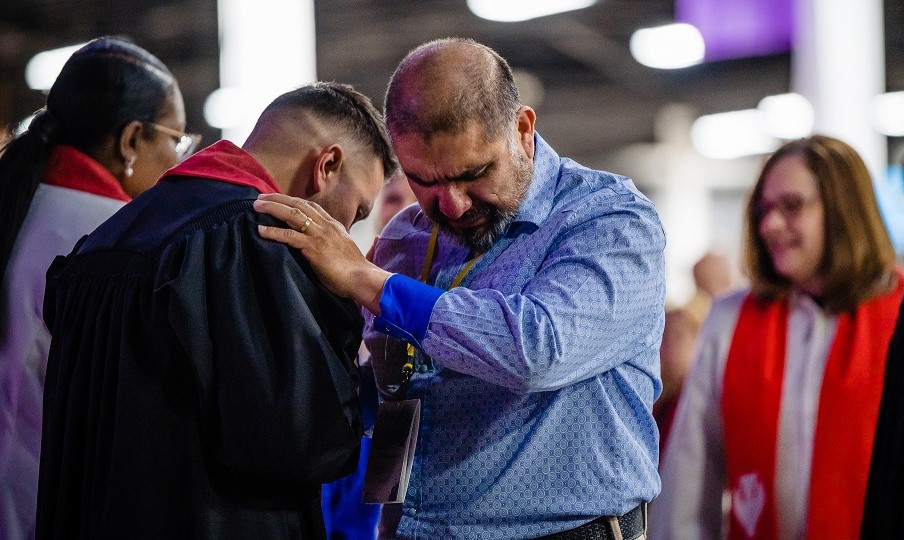 At EPA's 2023 Annual Conference attendees respond to a call to explore ministry. Corbin Payne photo
At EPA's 2023 Annual Conference attendees respond to a call to explore ministry. Corbin Payne photo
“As the Father has sent me, so I send you.” —John 20:21b
After his resurrection Jesus’ demonstrated his own practice of leadership succession. He lingered with his disciples to further instruct and strengthen their personal faith. And he assured them of the coming Holy Spirit to empower their lives and ministries. Then he said, “Now go; feed my sheep.”
Our local churches today would do well to explore their responsibility for raising up next-generation leaders, and to hone some best practices in creating a Culture of Calling to Ministry.
How? In her terrific book Thinking About Leadership, former Duke University President Nan Koehane reminds us, “One of the main responsibilities of a leader to her subordinates is to help them develop and exercise their talents as leaders” (p. 61). Specifically, that means “learning to articulate their own views, to develop strategies to accomplish goals, and to persuade and involve other people (in the mission)” (p. 228).
Does your congregation encourage gifted, young (and not-so-young) people to develop and practice leadership skills in the life of the church? My own call to ministry was definitely both personal and ecclesial, as my mentor at the time explained it should be.
The congregation at West Chester UMC gave me full reign to practice on them. My first sermon in 1978 was a bit of a trainwreck homiletically (I would learn later)…but the encouragement and training I received from the church continued. And eventually a decent pastor emerged.
Similarly, our best local churches today nurture and encourage promising, young leaders most effectively as they relinquish any expectations that the future must be just like the past. Even when a leadership change has been requested in an organization, Ron Heifetz warns against this common tendency “…to suspend the uncertain future and retain a more familiar and comfortable past.” (Leadership on the Line, p.36)
The “return to Egypt” committees in our churches (Exodus 16:3) are emblematic of this. But every effective leader today has a testimony of gratitude to share about churches or other workplaces that embraced ”uncertain futures” and permitted God’s creativity to reveal a new thing (Isaiah 43:19).
Would anyone sample this entrepreneurial spirit in your church? Our emerging leaders deserve it.
What are the best practices of EPA congregations that have produced the highest number of pastors among us? Curiosity—and also practicality—might inspire us to investigate more closely, especially in light of our diminishing numbers of new clergy over the past decade.
Several of us this spring studied a file titled “Recommending Churches,” seeking to identify those churches in our conference that have the most “Clergy Sons & Daughters.” We counted the numbers of clergy and ministry candidates from their congregations who currently serve as appointed pastors across our four districts.
The top producers include: Hopewell UMC (9), First UMC Lancaster (5) and Langhorne (4). Honorable mention, with 3 each, goes to: Fox Chase UMC Philadelphia; Royersford UMC; Salem UMC Danielsville; Fritz UMC Bethlehem; St. John’s UMC Shamokin; and St. Matthew’s UMC Trevose. These churches—and others—may have valuable wisdom to share with us. And this list is likely incomplete, so please enlighten us if you know of others.
New conference initiatives are currently in progress, bringing promising new clergy leaders into our churches. That includes the sharing of appointed pastors from our sister conference, Greater New Jersey, and also GNJ’s Mosaic program, which partners with local seminaries and congregations to attract and deploy some of the best and brightest young candidates.
But our local churches continue to have a key role and responsibility, as well! The commissioning of Barnabas and Saul (Acts 13:1-3) might inspire ideas and strategies pertinent to your church, such as encouraging fasting, prayer and contemplation; and laying on of hands as you invoke the Holy Spirit. Recommended leadership succession practices from secular sources might also be helpful.
A great way to begin the conversation in your congregation might be to plan and implement an annual worship service dedicated to the theme of recognizing and responding to the Call to Ministry. You may be surprised by who comes forth—whether immediately or eventually—in response to that emphasis and says, “Here am I. Send me!” (Isaiah 6:8)
Plentiful is the harvest of people in our churches and communities who need to be inspired and influenced by gifted, trained leaders. But fewer and fewer are the clergy laborers who come forward to lead them. (Luke 10:2) How is your church nurturing a culture to support and strengthen the call to pastoral ministry? Please tell us, so that we can share your good news with others. Contact me at smorton@epaumc.church.
Questions for review:
1. Who were the most recent professional/ordained ministry candidates emerging from your congregation?
2. How could your congregation elevate its expectations and recognition that God might actually be calling members of your church to pastoral ministry?
3. What resources could your church offer to make a candidate’s path toward ordination a bit easier?
NOTES:
Use a suggested order of worship celebrating the call, prepared by two of our EPA North District pastors and members of BOOM. It’s titled Here I Am, Send Me: Call to Ministry Worship Service. Plan to use it in your church, and please recommend it to others.
Also, read Part 1 in this series of essays: “Creating a culture of calling to pastoral ministry is crucial now.” (May 1, 2023)
*The Rev. Steven Morton is the EPA Conference’s Leadership Development Manager, whose work focuses on EPA’s Pathways to Congregational Fruitfulness & Health initiative. Learn about Pathways.
